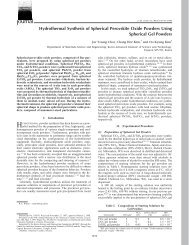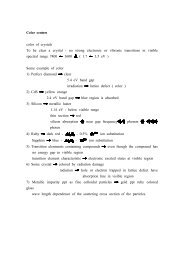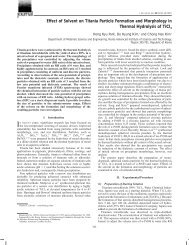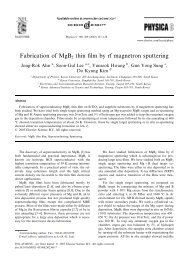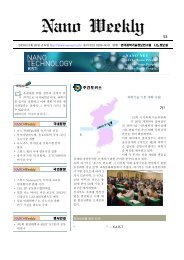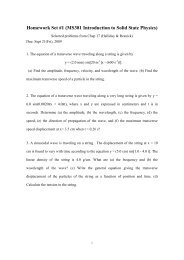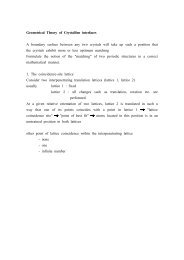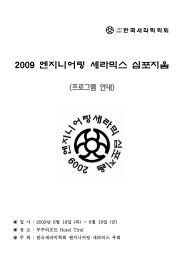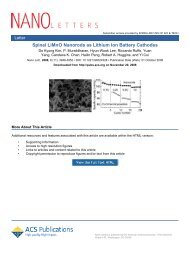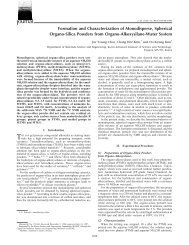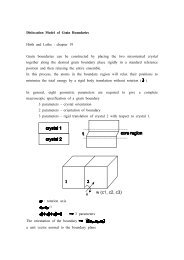Synthesis of Li TiO ceramic breeder powders by the combustion ...
Synthesis of Li TiO ceramic breeder powders by the combustion ...
Synthesis of Li TiO ceramic breeder powders by the combustion ...
You also want an ePaper? Increase the reach of your titles
YUMPU automatically turns print PDFs into web optimized ePapers that Google loves.
Ž .<br />
Journal <strong>of</strong> Nuclear Materials 253 1998 203–212<br />
<strong>Syn<strong>the</strong>sis</strong> <strong>of</strong> <strong>Li</strong> <strong>TiO</strong> <strong>ceramic</strong> <strong>breeder</strong> <strong>powders</strong> <strong>by</strong> <strong>the</strong> <strong>combustion</strong><br />
2 3<br />
process<br />
C.H. Jung a,) , J.Y. Park a , S.J. Oh a , H.K. Park a , Y.S. Kim a , D.K. Kim b , J.H. Kim b<br />
Abstract<br />
a Hi-Tech Ceramics Team, Korea Atomic Energy Research Institute, Taejon, South Korea<br />
b Department <strong>of</strong> Materials Science and Engineering, Korea AdÕanced Institute <strong>of</strong> Science and Technology, Taejon, South Korea<br />
The syn<strong>the</strong>sis <strong>of</strong> <strong>the</strong> ultra-fine <strong>Li</strong> <strong>TiO</strong> powder <strong>by</strong> <strong>the</strong> <strong>combustion</strong> reaction <strong>of</strong> lithium nitrate, titanium nitrate and specific<br />
2 3<br />
fuels was investigated. Ultrafine <strong>Li</strong> <strong>TiO</strong> <strong>powders</strong> could be syn<strong>the</strong>sized using glycine or a mixture <strong>of</strong> urea and citric acid. A<br />
2 3<br />
pure <strong>Li</strong> <strong>TiO</strong> phase was obtained <strong>by</strong> <strong>the</strong> simple process without fur<strong>the</strong>r calcination reaction. The specific surface area <strong>of</strong> <strong>the</strong><br />
2 3<br />
as-syn<strong>the</strong>sized powder was 10 to 14 m 2 rg and <strong>the</strong> primary particle size was about 30 nm. The <strong>Li</strong> <strong>TiO</strong> body sintered at<br />
2 3<br />
8008C for 3 h had dense agglomerates which were formed <strong>by</strong> <strong>the</strong> inter-agglomerate sintering process. Each <strong>of</strong> <strong>the</strong><br />
agglomerates consisted <strong>of</strong> very fine grains with a size <strong>of</strong> 0.3 to 0.5 mm. q 1998 Elsevier Science B.V.<br />
1. Introduction<br />
The choice <strong>of</strong> a suitable breeding material for D–T<br />
fueled fusion reactors is very important in view <strong>of</strong> <strong>the</strong><br />
effective power conversion, tritium release behaviors and<br />
safety considerations wx 1 . <strong>Li</strong>thium-based <strong>ceramic</strong>s such as<br />
<strong>Li</strong>2O, g-<strong>Li</strong>AlO 2, <strong>Li</strong>4SiO 4, <strong>Li</strong>2ZrO3 and <strong>Li</strong>2<strong>TiO</strong>3 have<br />
been considered as candidates for tritium breeding materi-<br />
als in D–T fusion reactors w2,3 x.<br />
<strong>Li</strong>2<strong>TiO</strong>3 is known to be a low-activation <strong>ceramic</strong> material<br />
for use in tritium breeding. To date, however, very<br />
little work has been done on <strong>the</strong> fabrication <strong>of</strong> <strong>the</strong> <strong>Li</strong>2<strong>TiO</strong>3 <strong>ceramic</strong> powder, <strong>the</strong> sintering behavior, <strong>the</strong> tritium release<br />
behavior and <strong>the</strong> properties database wx 4 . Finn et al. wx 5<br />
performed preliminary research which indicated that<br />
<strong>Li</strong>2<strong>TiO</strong>3 possessed attractive properties. <strong>Li</strong>2<strong>TiO</strong>3 has <strong>the</strong><br />
same lithium density as that for <strong>Li</strong>2ZiO3 and its melting<br />
point is similar. The <strong>the</strong>rmal conductivity is better than<br />
that for lithium aluminate or lithium zirconate. Long-term<br />
waste problems should be low because titanium is <strong>the</strong> low<br />
activation element. In addition, <strong>Li</strong>2<strong>TiO</strong>3 appears to possess<br />
excellent tritium release behaviors at temperatures below<br />
3008C wx 4 .<br />
)<br />
Corresponding author. Fax: q82-42 862 5496; e-mail:<br />
chung1@nanum.karei.re.kr.<br />
0022-3115r98r$19.00 q 1998 Elsevier Science B.V. All rights reserved.<br />
Ž .<br />
PII S0022-3115 97 00313-9<br />
In this study, a novel method for preparing fine-crystalline<br />
<strong>Li</strong>2<strong>TiO</strong>3 <strong>powders</strong>, that is based on <strong>the</strong> <strong>combustion</strong><br />
reaction, is reported. Several conventional powder syn<strong>the</strong>sis<br />
techniques including solid state syn<strong>the</strong>sis, co-precipita-<br />
tion and sol–gel process are available wx 6 . However, <strong>the</strong>se<br />
reactions are complicated and require multi-step reaction<br />
routes with long term reactions. Therefore, a simple process<br />
is needed. One <strong>of</strong> <strong>the</strong> simplest powder preparation<br />
processes is <strong>combustion</strong> syn<strong>the</strong>sis w7,8 x.<br />
This process is an<br />
exploitation <strong>of</strong> an exo<strong>the</strong>rmic and usually very rapid chem-<br />
ical reaction to form final reaction products wx 9 . A key<br />
feature <strong>of</strong> this process is that <strong>the</strong> heat required to maintain<br />
<strong>the</strong> chemical reaction is supplied from <strong>the</strong> reaction itself<br />
Ž internal source. and not from an external source.<br />
Many advantages <strong>of</strong> this technique have been demonstrated<br />
in <strong>the</strong> past as follows. Ž. 1 The method needs little<br />
heating to start a rapid reaction. Ž. 2 The method requires<br />
little or no fur<strong>the</strong>r processing such as calcination and<br />
milling. There is a considerable savings in time, energy<br />
and equipment compared with <strong>the</strong> conventional techniques.<br />
Ž. 3 The process can be applied to prepare novel-oxides<br />
containing dopant elements, low-temperature compounds<br />
and cermets which are difficult to syn<strong>the</strong>size <strong>by</strong> <strong>the</strong> conventional<br />
methods. Ž. 4 The process uses <strong>the</strong> heat generated<br />
<strong>by</strong> <strong>the</strong> chemical reaction between fuel and metal nitrates to<br />
convert <strong>the</strong> metal ions to <strong>the</strong> target <strong>ceramic</strong>s materials w10 x.
204<br />
Ž. 5 The <strong>combustion</strong> syn<strong>the</strong>sized <strong>powders</strong> with wet chemical<br />
techniques have good sinterability because most <strong>of</strong><br />
<strong>the</strong>m are produced in ultrafine form. This wet chemical<br />
route allows <strong>the</strong> degree <strong>of</strong> mixing <strong>of</strong> <strong>the</strong> reactants to be<br />
better than <strong>by</strong> directly blending <strong>the</strong> solid reactants.<br />
In this study, <strong>the</strong> <strong>combustion</strong> behavior <strong>of</strong> various fuels<br />
and fuel composition on <strong>the</strong> phase formation were investigated<br />
to syn<strong>the</strong>size <strong>the</strong> ultra-fine <strong>Li</strong>2<strong>TiO</strong>3 powder <strong>by</strong> <strong>the</strong><br />
<strong>combustion</strong> reaction. Additionally, <strong>the</strong> sintering behavior<br />
<strong>of</strong> <strong>the</strong> <strong>combustion</strong> syn<strong>the</strong>sized powder will also be discussed.<br />
2. Experimental procedure<br />
The <strong>combustion</strong> process is a self-sustaining <strong>combustion</strong><br />
syn<strong>the</strong>sis technique that produces fine homogeneous<br />
metal-oxide <strong>powders</strong>. Aqueous precursor solutions containing<br />
metal nitrates and fuel such as urea, citric acid and<br />
glycine were heated until <strong>the</strong> water was evaporated. After<br />
evaporation <strong>of</strong> <strong>the</strong> water, <strong>the</strong> precursor mixture auto-ignited<br />
and underwent <strong>combustion</strong> spontaneously to form <strong>the</strong><br />
metal-oxides.<br />
Titanium nitrates were used as a source material <strong>of</strong><br />
titanium because <strong>the</strong> water soluble TiŽ IV. ion exists only<br />
in a strong acid media. Titanium nitrate is not commercially<br />
available and was prepared according to <strong>the</strong> path<br />
shown in Fig. 1. It was prepared <strong>by</strong> dissolving hydrated<br />
titania in nitric acid. The hydrated titania was obtained <strong>by</strong><br />
adding TiCl aqueous solution to ammonia solution. Hy-<br />
4<br />
drated titania was carefully washed with distilled water<br />
until <strong>the</strong> chloride ions were fully removed. After <strong>the</strong>se<br />
Fig. 1. Flow sheet <strong>of</strong> <strong>the</strong> <strong>combustion</strong> process for syn<strong>the</strong>sis <strong>of</strong> <strong>the</strong><br />
<strong>Li</strong> <strong>TiO</strong> powder.<br />
2 3<br />
C.H. Jung et al.rJournal <strong>of</strong> Nuclear Materials 253 1998 203–212<br />
metal salts Ž<strong>Li</strong>NO and <strong>TiO</strong>Ž NO . . and fuel were dis-<br />
3 3 2<br />
solved in water, this precursor solution was heated with<br />
stirring. As soon as <strong>the</strong> water was evaporated, <strong>the</strong> precursor<br />
mixture spontaneously ignited <strong>by</strong> burning <strong>of</strong> <strong>the</strong> metal<br />
nitrate and fuel and fine <strong>Li</strong> <strong>TiO</strong> powder was formed with<br />
2 3<br />
<strong>the</strong> release <strong>of</strong> gas like N , CO and H O. The composition<br />
2 2 2<br />
<strong>of</strong> fuel and metal nitrates was calculated according to <strong>the</strong><br />
method <strong>of</strong> Jain et al. w11 x.<br />
A ‘stoichiometric’ composition<br />
denotes a fuel-to-nitrate ratio in which <strong>the</strong> fuel can react<br />
completely with all <strong>of</strong> <strong>the</strong> metal nitrates in <strong>the</strong> same<br />
mixture, such that no residual fuel or nitrate remains in <strong>the</strong><br />
product materials.<br />
The <strong>combustion</strong> syn<strong>the</strong>sis for <strong>Li</strong>2<strong>TiO</strong>3 was done according<br />
to <strong>the</strong> flow sheet shown in Fig. 1. The <strong>combustion</strong><br />
reaction was completed within 20 s. The crystalline phases<br />
<strong>of</strong> as-syn<strong>the</strong>sized <strong>powders</strong> were determined <strong>by</strong> X-ray<br />
diffractometry with radiation <strong>of</strong> Cu Ka Ž Rigaku. at <strong>the</strong><br />
scan speed <strong>of</strong> 18rmin. Scanning electron microscopy<br />
Ž SEM, JEOL. and transmission electron microscopy ŽTEM,<br />
JEOL 2000FX-2, 200 keV . , were used to observe <strong>the</strong><br />
morphology and size <strong>of</strong> <strong>the</strong> syn<strong>the</strong>sized <strong>powders</strong>. Simultaneous<br />
<strong>the</strong>rmogravimetric and differential <strong>the</strong>rmal analysis<br />
Ž TGrDTA. and differential scanning calorimetry Ž DSC.<br />
were performed to analyze <strong>the</strong> <strong>the</strong>rmal behaviors <strong>of</strong> <strong>the</strong><br />
precursor solution and <strong>the</strong> syn<strong>the</strong>sized <strong>powders</strong>. The specific<br />
surface area <strong>of</strong> <strong>the</strong> syn<strong>the</strong>sized <strong>Li</strong>2<strong>TiO</strong>3 <strong>powders</strong> was<br />
measured with BET method.<br />
To compare <strong>the</strong> characteristics <strong>of</strong> <strong>combustion</strong> syn<strong>the</strong>sized<br />
<strong>powders</strong> with those <strong>of</strong> solid state reacted ones, o<strong>the</strong>r<br />
<strong>powders</strong> were also prepared <strong>by</strong> <strong>the</strong> mechanical mixing <strong>of</strong><br />
<strong>Li</strong>2CO3 and <strong>TiO</strong>2 and calcined at 400 to 10008C for3h.<br />
3. Results and discussion<br />
3.1. Phase formation with fuel type and composition<br />
The type and <strong>the</strong> composition <strong>of</strong> fuels in <strong>the</strong> <strong>combustion</strong><br />
syn<strong>the</strong>sis can strongly influence <strong>the</strong> reactivity <strong>of</strong> <strong>the</strong><br />
<strong>combustion</strong> reaction and <strong>the</strong> phases formed in <strong>the</strong> syn<strong>the</strong>sized<br />
<strong>powders</strong>. If only nitrates were dissolved in a precursor<br />
solution without any fuels, <strong>the</strong>n hard lumps remained<br />
without any <strong>combustion</strong> reaction during heating. But when<br />
fuels were mixed along with nitrates, <strong>the</strong> precursor solution<br />
could be reacted with or without a flame present. The<br />
reactivity <strong>of</strong> <strong>the</strong> <strong>combustion</strong> reaction is dependent upon <strong>the</strong><br />
ligand groups <strong>of</strong> <strong>the</strong> fuel molecule and <strong>the</strong> compositional<br />
ratio <strong>of</strong> fuel to nitrates.<br />
Therefore, <strong>the</strong> reactivity and <strong>the</strong> product phases from<br />
metal Ž <strong>Li</strong>, Ti. nitrates with various fuels were investigated<br />
before <strong>the</strong> syn<strong>the</strong>sis <strong>of</strong> <strong>Li</strong> <strong>TiO</strong> powder <strong>by</strong> <strong>the</strong> <strong>combustion</strong><br />
2 3<br />
reaction was undertaken. These results are summarized in<br />
Table 1. <strong>Li</strong>NO is reacted with citric acid or glycine.<br />
3<br />
However, <strong>the</strong> produced phase is not <strong>Li</strong> O but <strong>Li</strong> CO ,<br />
2 2 3<br />
which seems to be to due to <strong>the</strong> CO adsorption character-<br />
2
C.H. Jung et al.rJournal <strong>of</strong> Nuclear Materials 253 1998 203–212 205<br />
Table 1<br />
Combustion behavior <strong>of</strong> <strong>Li</strong>NO and <strong>TiO</strong>Ž NO .<br />
3 3 2 with various fuels<br />
Reactant composition Ž stoichiometric. Reactivity Phase<br />
<strong>Li</strong>NO3 urea no reaction <strong>Li</strong> 2CO3q<strong>Li</strong>NO3 crystalline<br />
citric acid very explosive <strong>Li</strong> 2CO3 crystalline<br />
glycine very explosive <strong>Li</strong> 2CO3q<strong>Li</strong>NO3 crystalline<br />
<strong>TiO</strong>Ž NO . 3 2<br />
urea<br />
citric acid<br />
no reaction<br />
weak reaction<br />
anatase<br />
anatase<br />
glycine weak reaction anatase<br />
istics <strong>of</strong> <strong>Li</strong>-compounds from glycine or citric acid during<br />
<strong>the</strong> <strong>combustion</strong> reaction and atmosphere w12 x.<br />
Although<br />
glycine reacts on lithium nitrate with flame, not all phases<br />
are <strong>Li</strong>2CO 3.<br />
This seems to result from <strong>the</strong> excess amine<br />
group which is not complexed with lithium ions.<br />
<strong>TiO</strong>Ž NO . 3 2 is not reacted with urea but weakly reacted<br />
with glycine or citric acid. However, all <strong>the</strong> phases are<br />
anatase which is <strong>the</strong> low temperature phase <strong>of</strong> titanium<br />
oxide, i.e. <strong>the</strong> heat from <strong>the</strong> <strong>combustion</strong> reaction seems to<br />
be too small to produce <strong>the</strong> rutile phase. The reactivity <strong>of</strong><br />
<strong>the</strong> mixture <strong>of</strong> <strong>Li</strong>NO –<strong>TiO</strong>Ž NO .<br />
3 3 2 was different from that<br />
<strong>of</strong> each <strong>of</strong> <strong>the</strong> nitrates. The fuels consisted <strong>of</strong> both <strong>the</strong><br />
carboxylic acid group and amine group like glycine or a<br />
mixture <strong>of</strong> urea and citric acid were strongly reacted with<br />
mixed metal Ž <strong>Li</strong>, Ti. nitrates. The reactivity <strong>of</strong> this system<br />
was strongly dependent on <strong>the</strong> composition <strong>of</strong> fuels. The<br />
strong reaction occurred only at <strong>the</strong> stoichiometric ratio <strong>of</strong><br />
fuel and nitrates. The reactivity and <strong>the</strong> produced phases<br />
are summarized in Table 2. Among various compositions<br />
<strong>of</strong> fuels, <strong>the</strong> stoichiometric composition <strong>of</strong> glycine or a<br />
mixture <strong>of</strong> urea and citric acid produced <strong>the</strong> <strong>Li</strong>2<strong>TiO</strong>3 phase<br />
with a strong reaction. The <strong>powders</strong> prepared <strong>by</strong> <strong>the</strong><br />
<strong>combustion</strong> process had <strong>the</strong> specific surface area <strong>of</strong> 10 to<br />
20 m2rg which was dependant on <strong>the</strong> type and composition<br />
<strong>of</strong> <strong>the</strong> fuel.<br />
The self-sustaining nature <strong>of</strong> <strong>the</strong> <strong>combustion</strong> can be<br />
explained as follows. The precursor mixture contains, a<br />
strong oxidizer, metal nitrate, and also contains glycine or<br />
citric acid, a readily combustible fuel. On heating, <strong>the</strong><br />
precursor mixture, after evaporating water, nitrate decomposes<br />
giving oxides <strong>of</strong> nitrogen Ž NO . x . The gaseous NOx<br />
reacts with <strong>the</strong> fuel Ž glycine or citric acid. generating heat<br />
Ž flame. and more gases. The homogeneous gas-phase<br />
exo<strong>the</strong>rmic oxidation–reduction increases <strong>the</strong> temperature<br />
<strong>of</strong> <strong>the</strong> intact viscous mixture immediately adjoining to <strong>the</strong><br />
<strong>combustion</strong> zone, causing it to react. The reaction process<br />
proceeds rapidly and sustainedly until all <strong>of</strong> <strong>the</strong> intact zone<br />
is consumed. The rapid temperature increase with <strong>the</strong><br />
orange flame and <strong>the</strong> volume <strong>of</strong> gas generated during <strong>the</strong><br />
reaction depend on <strong>the</strong> fuel type, composition and content;<br />
in general, a higher fuel content or stoichiometric composition<br />
gives rise to higher temperature and to more evolved<br />
gas.<br />
XRD patterns <strong>of</strong> <strong>the</strong> syn<strong>the</strong>sized powder prepared <strong>by</strong><br />
various fuels are shown in Fig. 2. When pure urea Žmark<br />
A<br />
in Fig. 2. or mixed fuel <strong>of</strong> urea and citric acid with<br />
composition <strong>of</strong> urearcitric acid equal to 12 Ž mark B. was<br />
used as a fuel, <strong>Li</strong>NO and <strong>TiO</strong> Ž anatase. 3 2 phases were<br />
found in <strong>the</strong> syn<strong>the</strong>sized <strong>powders</strong>. This observation seems<br />
to be related to heat produced from <strong>the</strong> <strong>combustion</strong> reaction.<br />
When pure glycine Ž mark F. and mixed fuels <strong>of</strong> urea<br />
and citric acid with <strong>the</strong> same ratio Ž mark C. or excess <strong>of</strong><br />
citric acid Ž mark D. were used as fuels, <strong>Li</strong>2<strong>TiO</strong>3 could be<br />
easily obtained. However, an unreacted residue phase<br />
seemed to exist along with <strong>Li</strong>2<strong>TiO</strong>3 in <strong>the</strong> excess citric<br />
acid fuel. Similar results were observed with mixed fuel<br />
Table 2<br />
Effects <strong>of</strong> fuel type and composition on <strong>the</strong> syn<strong>the</strong>sis <strong>of</strong> <strong>Li</strong> 2<strong>TiO</strong>3 powder<br />
Composition <strong>of</strong> <strong>the</strong> fuel Ž mol. Ž for 1 mol <strong>of</strong> <strong>Li</strong> <strong>TiO</strong> .<br />
Reactivity Phase Ž XRD. Remark Ž 2 BET m rg.<br />
2 3<br />
urea citric acid glycine<br />
10r3 – – no reaction <strong>Li</strong>NO , <strong>TiO</strong> Ž anatase. 3 2<br />
A –<br />
8r3 2r9 – no reaction <strong>Li</strong>NO , <strong>TiO</strong> Ž anatase. 3 2<br />
B –<br />
5r3 5r9 – strong reaction <strong>Li</strong> 2<strong>TiO</strong>3 C 17.01<br />
2r3 8r9 – moderate reaction <strong>Li</strong> <strong>TiO</strong> Ž impurity. 2 3<br />
D 19.23<br />
– 10r9 – weak reaction <strong>Li</strong> <strong>TiO</strong> Ž impurity. 2 3<br />
E 28.49<br />
– – 20r9 very strong reaction <strong>Li</strong> 2<strong>TiO</strong>3 F 13.50
206<br />
C.H. Jung et al.rJournal <strong>of</strong> Nuclear Materials 253 1998 203–212<br />
Fig. 2. XRD patterns <strong>of</strong> as-syn<strong>the</strong>sized <strong>powders</strong> with various fuel types and compositions.
C.H. Jung et al.rJournal <strong>of</strong> Nuclear Materials 253 1998 203–212 207<br />
Fig. 3. SEM photographs <strong>of</strong> as-syn<strong>the</strong>sized <strong>powders</strong> with fuel type: Ž A. urea, Ž B. urea)citric acid, Ž C. ureascitric acid, Ž D. urea-citric<br />
acid, Ž E. citric acid and Ž F. glycine.
208<br />
with excess citric acid in <strong>the</strong> case <strong>of</strong> pure citric acid as a<br />
fuel. The reactivity <strong>of</strong> pure citric acid was lower than<br />
mixed fuel with excess citric acid, i.e. to syn<strong>the</strong>size<br />
<strong>Li</strong>2<strong>TiO</strong>3 powder <strong>by</strong> <strong>combustion</strong> reaction, a fuel must<br />
possess both <strong>the</strong> carboxylic acid group and amine group.<br />
The microstructures <strong>of</strong> <strong>the</strong> syn<strong>the</strong>sized <strong>powders</strong> using<br />
various fuels were observed. A typical micrograph <strong>of</strong> <strong>the</strong><br />
syn<strong>the</strong>sized <strong>powders</strong> is shown in Fig. 3. The <strong>powders</strong><br />
prepared from pure urea Ž A in Fig. 3. and a mixed fuel<br />
with excess urea composition Ž B in Fig. 3. had a cluster <strong>of</strong><br />
aggregates, which were <strong>Li</strong>NO , <strong>TiO</strong> Ž anatase. and unre-<br />
C.H. Jung et al.rJournal <strong>of</strong> Nuclear Materials 253 1998 203–212<br />
3 2<br />
acted fuels. In both cases, <strong>the</strong> reaction is very weak. By<br />
contrast, <strong>the</strong> syn<strong>the</strong>sized <strong>Li</strong>2<strong>TiO</strong>3 <strong>powders</strong> using glycine<br />
Ž F in Fig. 3. formed <strong>the</strong> foamy agglomerated particles.<br />
A lot <strong>of</strong> pores were found on <strong>the</strong> surface <strong>of</strong> <strong>the</strong><br />
syn<strong>the</strong>sized <strong>powders</strong>, which seems to result from <strong>the</strong><br />
evolved gas during <strong>the</strong> <strong>combustion</strong> reaction. The SAD<br />
Ž selected area diffraction. pattern and <strong>the</strong> microstructure <strong>of</strong><br />
as-syn<strong>the</strong>sized powder observed <strong>by</strong> TEM are shown in Fig.<br />
4. While <strong>the</strong> morphology <strong>of</strong> secondary particles was a<br />
porous skeleton, <strong>the</strong> primary particles were ultra-fine and<br />
equiaxed crystalline with a particle size <strong>of</strong> about 20 nm.<br />
The SAD pattern shows clear rings, which means that <strong>the</strong><br />
syn<strong>the</strong>sized powder is very fine crystalline.<br />
Considering <strong>the</strong> above results, <strong>the</strong> <strong>Li</strong> <strong>TiO</strong> powder<br />
2 3<br />
could be easily syn<strong>the</strong>sized <strong>by</strong> <strong>the</strong> <strong>combustion</strong> reaction<br />
with glycine or a mixed fuel <strong>of</strong> urea and citric acid which<br />
is consisted <strong>of</strong> both <strong>of</strong> amine group and carboxylic group.<br />
3.2. Phase formation with ratio <strong>of</strong> fuel to nitrate<br />
It is known that one <strong>of</strong> <strong>the</strong> major parameters that<br />
determines <strong>the</strong> phase formation and <strong>the</strong> morphology <strong>of</strong> <strong>the</strong><br />
syn<strong>the</strong>sized powder is <strong>the</strong> ratio <strong>of</strong> fuel to metal nitrate in<br />
<strong>the</strong> <strong>combustion</strong> reaction w9,10 x.<br />
When a precursor solution<br />
has <strong>the</strong> stoichiometric ratio <strong>of</strong> fuels to metal nitrates, <strong>the</strong><br />
reactivity and <strong>the</strong> phase formation are <strong>the</strong> most desirable.<br />
In this study, effects <strong>of</strong> <strong>the</strong> ratio <strong>of</strong> fuels to metal nitrates<br />
on <strong>the</strong> characteristics <strong>of</strong> <strong>the</strong> syn<strong>the</strong>sized powder were<br />
investigated in a precursor solution consisting <strong>of</strong> glycine as<br />
a fuel and a mixed nitrate <strong>of</strong> lithium and titanium.<br />
Fig. 5 shows XRD patterns for <strong>Li</strong> <strong>TiO</strong> produced at<br />
2 3<br />
three different ratios <strong>of</strong> glycine to nitrates. Three different<br />
compositions are fuel-lean which denotes <strong>the</strong> precursor<br />
solution contains glycine with one-half <strong>of</strong> <strong>the</strong> stoichiometric<br />
ratio, fuel-rich which denotes <strong>the</strong> precursor solution<br />
contains two times <strong>of</strong> glycine and fuel-stoichiometric. The<br />
Fig. 4. Bright-field TEM image and SAD pattern <strong>of</strong> as-syn<strong>the</strong>sized <strong>Li</strong> <strong>TiO</strong> <strong>powders</strong>.<br />
2 3
C.H. Jung et al.rJournal <strong>of</strong> Nuclear Materials 253 1998 203–212 209<br />
Fig. 5. XRD patterns for <strong>Li</strong> <strong>TiO</strong> syn<strong>the</strong>sized <strong>by</strong> <strong>the</strong> <strong>combustion</strong> reaction with three different ratios <strong>of</strong> glycine to nitrate Ž<br />
2 3<br />
open circle:<br />
anatase . .<br />
Fig. 6. DSC curve <strong>of</strong> precursor mixture with glycine and Ž<strong>Li</strong><br />
and<br />
Ti. nitrates.<br />
Fig. 7. DTArTG analysis curves <strong>of</strong> as-syn<strong>the</strong>sized <strong>Li</strong> <strong>TiO</strong> pow-<br />
2 3<br />
der <strong>by</strong> <strong>the</strong> <strong>combustion</strong> reaction.
210<br />
syn<strong>the</strong>sized <strong>powders</strong> prepared using <strong>the</strong> fuel-stoichiometric<br />
and fuel-rich consisted <strong>of</strong> fully crystalline <strong>Li</strong>2<strong>TiO</strong>3 with an<br />
average primary crystalline size <strong>of</strong> about 30 nm which is<br />
determined <strong>by</strong> XRD line broadening analysis. However,<br />
unreacted residues co-existed in <strong>the</strong> syn<strong>the</strong>sized powder<br />
prepared <strong>by</strong> <strong>the</strong> fuel-rich precursor solution. Most <strong>of</strong> <strong>the</strong><br />
crystalline phases produced <strong>by</strong> <strong>the</strong> precursor solution with<br />
<strong>the</strong> fuel-lean process are anatase and small amounts <strong>of</strong><br />
unreacted residue also co-existed. This observation means<br />
that <strong>the</strong> ratio <strong>of</strong> glycine to mixed nitrates <strong>of</strong> lithium and<br />
titanium is important in obtaining <strong>the</strong> fine crystalline<br />
<strong>Li</strong>2<strong>TiO</strong>3 <strong>powders</strong> <strong>by</strong> <strong>the</strong> <strong>combustion</strong> reaction.<br />
Variations <strong>of</strong> heat Ž or calorie. produced from <strong>the</strong> reactions<br />
during <strong>the</strong> heating <strong>of</strong> a precursor solution were<br />
C.H. Jung et al.rJournal <strong>of</strong> Nuclear Materials 253 1998 203–212<br />
analyzed <strong>by</strong> DSC. The small lump sample was prepared <strong>by</strong><br />
pre-drying <strong>of</strong> <strong>the</strong> precursor solution with a fuel-stoichiometric<br />
composition before <strong>the</strong> <strong>combustion</strong> reaction. The<br />
measured DSC curve was shown in Fig. 6. The exo<strong>the</strong>rmic<br />
peak occurs at 2088C which is associated with <strong>the</strong> redox<br />
reactions <strong>of</strong> burning <strong>the</strong> chemical groups involved in<br />
glycine. Up to 4008C, <strong>the</strong> decomposition was completed<br />
and <strong>the</strong> total weight loss was about 95%. The TG and DT<br />
analysis were also performed to investigate <strong>the</strong> existence<br />
<strong>of</strong> an unreacted residue in <strong>the</strong> as-syn<strong>the</strong>sized powder prepared<br />
<strong>by</strong> glycine with fuel-stoichiometric composition.<br />
Fig. 7 shows that weight losses were less than 5% and no<br />
<strong>the</strong>rmal peaks were observed up to 10008C, which indicated<br />
that pure <strong>Li</strong> <strong>TiO</strong> powder without a fur<strong>the</strong>r calcina-<br />
2 3<br />
Fig. 8. XRD patterns <strong>of</strong> <strong>the</strong> <strong>Li</strong> <strong>TiO</strong> powder prepared <strong>by</strong> solid state reaction; Ž. a after oven-drying, Ž. b after calcining at 5508C for 3 h, Ž.<br />
2 3<br />
c<br />
after calcining at 7008C for 3 h and Ž. d after calcining at 10008C for 3 h.
C.H. Jung et al.rJournal <strong>of</strong> Nuclear Materials 253 1998 203–212 211<br />
Fig. 9. The surface microstructure <strong>of</strong> <strong>Li</strong> <strong>TiO</strong> body sintered at 8008C for 3 h using <strong>the</strong> <strong>combustion</strong> syn<strong>the</strong>sized powder.<br />
2 3<br />
tion process could be easily syn<strong>the</strong>sized <strong>by</strong> this simple<br />
<strong>combustion</strong> process.<br />
3.3. Comparison <strong>of</strong> solid-state process with <strong>combustion</strong><br />
process<br />
A powder syn<strong>the</strong>sis process <strong>by</strong> <strong>the</strong> solid state reaction<br />
is <strong>the</strong> most well known method for syn<strong>the</strong>sis <strong>of</strong> <strong>the</strong> oxide<br />
<strong>ceramic</strong>s including <strong>Li</strong>2<strong>TiO</strong> 3. <strong>Li</strong>2<strong>TiO</strong>3 powder was produced<br />
<strong>by</strong> <strong>the</strong> solid state reaction <strong>of</strong> <strong>TiO</strong> Ž anatase. and<br />
<strong>Li</strong> CO in order to compare <strong>the</strong> characteristics <strong>of</strong> <strong>the</strong><br />
2 3<br />
syn<strong>the</strong>sized <strong>powders</strong>. A 1:1 stoichiometric mixture <strong>of</strong> titania<br />
and lithium carbonate was prepared <strong>by</strong> mixing toge<strong>the</strong>r<br />
with a zirconia ball in ethanol. Then, <strong>the</strong> mixed powder<br />
was dried at 1008C for 24 h and calcined in <strong>the</strong> range 400<br />
to 10008C for 3 h.<br />
Fig. 8 shows <strong>the</strong> XRD patterns <strong>of</strong> as-dried <strong>powders</strong><br />
with various calcination temperatures. The as-dried powder<br />
did not contain <strong>the</strong> <strong>Li</strong> <strong>TiO</strong> phase but did contain <strong>TiO</strong><br />
2 3 2<br />
Ž anatase. and small amounts <strong>of</strong> <strong>Li</strong>2CO 3. A <strong>Li</strong>2<strong>TiO</strong>3 phase<br />
appeared at 5508C, but <strong>TiO</strong> Ž anatase. 2 and small amounts<br />
<strong>of</strong> <strong>Li</strong>2CO3 were also observed along with <strong>Li</strong>2<strong>TiO</strong>3 phase<br />
at that temperature. When <strong>the</strong> calcination temperature<br />
reached 7008C, <strong>the</strong> observed phase was only <strong>Li</strong>2<strong>TiO</strong> 3.<br />
These phenomena can be confirmed <strong>by</strong> <strong>the</strong> TGrDT analysis.<br />
The DTA curve shows a broad endo<strong>the</strong>rmic peak in<br />
<strong>the</strong> range <strong>of</strong> 400 to 7008C, which is in agreement with <strong>the</strong><br />
calcining results above. Although <strong>Li</strong>2<strong>TiO</strong>3 is produced at<br />
7008C in <strong>the</strong> solid state reaction, this reaction required a<br />
long reaction time.<br />
2<br />
The shrinkage curves <strong>of</strong> <strong>the</strong> <strong>combustion</strong> syn<strong>the</strong>sized<br />
powder were shifted toward a lower temperature than<br />
those <strong>of</strong> <strong>the</strong> solid state reacted one. Fig. 9 shows <strong>the</strong><br />
surface microstructure <strong>of</strong> a sintered <strong>Li</strong> <strong>TiO</strong> body using<br />
2 3<br />
<strong>the</strong> <strong>combustion</strong> syn<strong>the</strong>sized powder which was sintered at<br />
8008C for 3 h. This <strong>Li</strong> <strong>TiO</strong> sintered body has dense<br />
2 3<br />
agglomerates which are formed <strong>by</strong> <strong>the</strong> inter-agglomerate<br />
sintering process. Each <strong>of</strong> <strong>the</strong> agglomerates consist <strong>of</strong> very<br />
fine grains with a size <strong>of</strong> 0.3 to 0.5 mm. Large pores<br />
present at <strong>the</strong> intra-agglomerates in <strong>the</strong> sintered body<br />
decrease <strong>the</strong> sintered density <strong>of</strong> <strong>the</strong> <strong>Li</strong> <strong>TiO</strong> powder com-<br />
2 3<br />
pact. Therefore, an additional de-agglomeration process<br />
would be necessary to increase <strong>the</strong> packing density and<br />
thus <strong>the</strong> sintering density.<br />
4. Conclusion<br />
Ultrafine <strong>Li</strong> <strong>TiO</strong> <strong>powders</strong> could be easily syn<strong>the</strong>sized<br />
2 3<br />
<strong>by</strong> a <strong>combustion</strong> reaction in a short time using glycine or a<br />
mixture <strong>of</strong> urea and citric acid with a stoichiometric<br />
composition. A pure <strong>Li</strong> <strong>TiO</strong> phase was obtained <strong>by</strong> <strong>the</strong><br />
2 3<br />
simple process without fur<strong>the</strong>r calcination reaction. The<br />
syn<strong>the</strong>sized powder was very fine and equiaxed. The specific<br />
surface area <strong>of</strong> <strong>the</strong> as-syn<strong>the</strong>sized powder is 10 to 14<br />
m 2 rg and <strong>the</strong> primary particle size is about 30 nm.<br />
A <strong>Li</strong> <strong>TiO</strong> body sintered at 8008C for 3 h has dense<br />
2 3<br />
agglomerates which were formed <strong>by</strong> an inter-agglomerate<br />
sintering process. Each <strong>of</strong> agglomerates consist <strong>of</strong> very<br />
fine grains with a size <strong>of</strong> 0.3 to 0.5 mm.
212<br />
References<br />
wx 1 E. Proust et al., Fusion Eng. Design 16 Ž 1991. 73.<br />
wx 2 C.E. Johnson, K.R. Kummer, E. Roth, J. Nucl. Mater. 155–<br />
157 Ž 1988. 188.<br />
wx 3 C.E. Johnson, in: P. Vincenzini Ž Ed. . , Ceramic Today–<br />
Tomorrow’s Ceramics, 1991, p. 3029.<br />
wx 4 J.M. Miller, H.D. Hamilton, J.D. Sulivan, J. Nucl. Mater.<br />
212–215 Ž 1984. 877.<br />
wx 5 P.A. Finn, T. Kurasawa, S. Nasu, K. Noda, Proc. IEEE 9th<br />
Symp. Eng. Problems <strong>of</strong> Fusion Research, Chicago, 1981, p.<br />
1200.<br />
wx 6 O. Renoult, J.-P. Boilot, J.-P. Korb, M. Boncoeur, J. Nucl.<br />
Mater. 223 Ž 1995. 126.<br />
C.H. Jung et al.rJournal <strong>of</strong> Nuclear Materials 253 1998 203–212<br />
wx 7 Y. Zhang, G.C. Stangle, J. Mater. Res. 9 Ž.Ž 8 1994. 1997.<br />
wx 8 S.B. Bhaduri, R. Radhakrishnan, D. <strong>Li</strong>nch, Ceram. Eng. Sci.<br />
Proc. 15 Ž.Ž 5 1994. 694.<br />
wx 9 L.A. Chick, L.R. Pederson, G.D. Maupin, J.L. Bates, Mater.<br />
Lett. 10 Ž.Ž 2 1990. 6.<br />
w10x L.A. Chick, L.R. Pederson, J.L. Bates, H.E. Kissinger, PNL-<br />
SA-17010, Oct. 1989, p. 170.<br />
w11x S.R. Jain, K.C. Adgo, V.R. Paivemeker, Combust. Flame 40<br />
Ž 1981. 71.<br />
w12x M. Windhoiz Ž Ed. . , The Merck Index, 10th ed., An Encyclopedia<br />
<strong>of</strong> Chemicals, Merk, Pahway, 1993.



